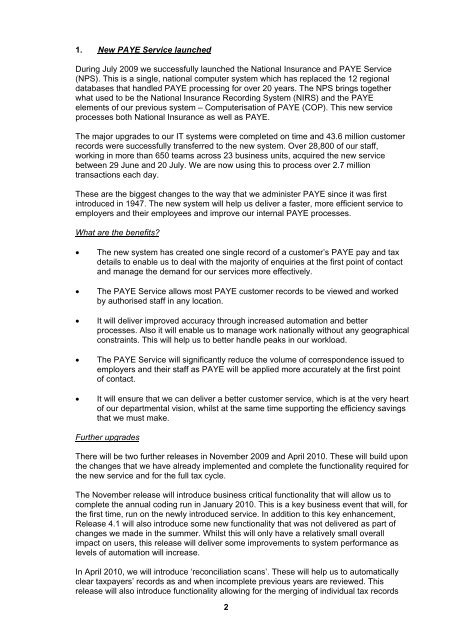Notes for Payroll Software Developers (PDF - HM Revenue & Customs
Notes for Payroll Software Developers (PDF - HM Revenue & Customs
Notes for Payroll Software Developers (PDF - HM Revenue & Customs
Create successful ePaper yourself
Turn your PDF publications into a flip-book with our unique Google optimized e-Paper software.
1. New PAYE Service launched<br />
During July 2009 we successfully launched the National Insurance and PAYE Service<br />
(NPS). This is a single, national computer system which has replaced the 12 regional<br />
databases that handled PAYE processing <strong>for</strong> over 20 years. The NPS brings together<br />
what used to be the National Insurance Recording System (NIRS) and the PAYE<br />
elements of our previous system – Computerisation of PAYE (COP). This new service<br />
processes both National Insurance as well as PAYE.<br />
The major upgrades to our IT systems were completed on time and 43.6 million customer<br />
records were successfully transferred to the new system. Over 28,800 of our staff,<br />
working in more than 650 teams across 23 business units, acquired the new service<br />
between 29 June and 20 July. We are now using this to process over 2.7 million<br />
transactions each day.<br />
These are the biggest changes to the way that we administer PAYE since it was first<br />
introduced in 1947. The new system will help us deliver a faster, more efficient service to<br />
employers and their employees and improve our internal PAYE processes.<br />
What are the benefits?<br />
• The new system has created one single record of a customer’s PAYE pay and tax<br />
details to enable us to deal with the majority of enquiries at the first point of contact<br />
and manage the demand <strong>for</strong> our services more effectively.<br />
• The PAYE Service allows most PAYE customer records to be viewed and worked<br />
by authorised staff in any location.<br />
• It will deliver improved accuracy through increased automation and better<br />
processes. Also it will enable us to manage work nationally without any geographical<br />
constraints. This will help us to better handle peaks in our workload.<br />
• The PAYE Service will significantly reduce the volume of correspondence issued to<br />
employers and their staff as PAYE will be applied more accurately at the first point<br />
of contact.<br />
• It will ensure that we can deliver a better customer service, which is at the very heart<br />
of our departmental vision, whilst at the same time supporting the efficiency savings<br />
that we must make.<br />
Further upgrades<br />
There will be two further releases in November 2009 and April 2010. These will build upon<br />
the changes that we have already implemented and complete the functionality required <strong>for</strong><br />
the new service and <strong>for</strong> the full tax cycle.<br />
The November release will introduce business critical functionality that will allow us to<br />
complete the annual coding run in January 2010. This is a key business event that will, <strong>for</strong><br />
the first time, run on the newly introduced service. In addition to this key enhancement,<br />
Release 4.1 will also introduce some new functionality that was not delivered as part of<br />
changes we made in the summer. Whilst this will only have a relatively small overall<br />
impact on users, this release will deliver some improvements to system per<strong>for</strong>mance as<br />
levels of automation will increase.<br />
In April 2010, we will introduce ‘reconciliation scans’. These will help us to automatically<br />
clear taxpayers’ records as and when incomplete previous years are reviewed. This<br />
release will also introduce functionality allowing <strong>for</strong> the merging of individual tax records<br />
2

















